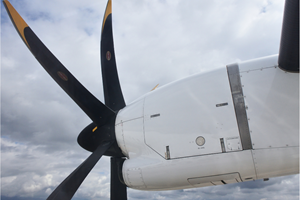What will the composites industry's post-pandemic future look like?
We already have the tools needed to help us craft our future, even if we do not know yet how and where those tools might be deployed.

As humans, we have the unique ability among all living creatures to comprehend the passage of time and use that comprehension to help us develop some understanding of the future. That is, we use information about the past and the present to generate predictions about the future. The vast majority of the time, this past-present-future consciousness works pretty well — or well enough that we can ably navigate events as they unfold in front of us. We do this as individual persons and collectively as communities, cities, companies, organizations, nation-states and humankind.
Our ability to project into the future, however, founders when we are confronted with unanticipated events, or when we are faced with events that do not have a recent historical corollary that allows us to predict what might happen next. In the current coronavirus pandemic, we are facing an unanticipated event that also has no recent historical corollary.
If you were like me, as work, travel and physical distance restrictions were implemented throughout March and April, you immediately scrapped the future mindset you previously held. You then attempted to build a new anticipated future based on how you thought the pandemic, restrictions, an economic shutdown, vaccine development and eventual recovery might play out.
The problem is that we are building this prediction with no recent historical corollary. Yes, I have heard analysts refer to the 2008-2009 Great Recession and 9/11, but neither of these events is a helpful guide. The Great Recession unfolded over several months and, although it was debilitating for millions of people, it did not result in an abrupt and nearly total shutdown of global economic and social systems for several months. The 9/11 attacks, although immediate and shocking, caused the cessation of some air travel for only a few days and produced relatively mild economic fallout.
What strategies and tactics will help you and your business navigate the next 12 months?
If you’re looking for a pandemic corollary, you have to go back to the 1918 flu pandemic, which infected 500 million people and killed 50 million. There are, however, a few problems if we want to use the 1918 flu pandemic to inform our view of the COVID-19 outbreak. First, we have no real memory of this event; there are few alive today who can tell us what the 1918 flu pandemic was like. Second, the world of 1918 hardly compares to ours: There was no automotive industry (to speak of), there was no aerospace industry, the option of working from home was nearly nonexistent and governments did not impose the same travel and contact restrictions we have today. On top of that, the healthcare industry in 1918 had no way to beat the flu virus — whether you lived or died was up to your immune system only.
So, here we sit, each ensconced in our homes, facing a rare and unanticipated global pandemic for which we have no history to help construct a feasible and sensible future. Each of us is forced to contemplate vague but possible outcomes for ourselves, our parents, our children, our friends, colleagues, our communities and our countries. We are also forced to contemplate possible outcomes for the composites industry.
Those outcomes seem varied, depending on the market. The commercial aerospace market, for example, clearly seems headed for a once-in-a-generation paradigm shift created by the unprecedented and sudden grounding of nearly all global passenger air travel. Similarly, the automotive industry is headed toward a couple years, at least, of depressed demand for new cars and trucks. On the other hand, the wind energy and industrial end markets appear, so far, to be weathering the pandemic well and could drive industry growth through the downturn we are sure to face.
Ultimately, however, our ability to envision a post-pandemic future might depend less on our past and more on our present. Baked into the composites industry — today — is a level of innovation, adaptability, vision and dynamism that conveys to each of us inherent advantages that are sure to help see us through the uncertain and fuzzy future we face. We already have the tools needed to help us craft our future, even if we do not yet know how and where those tools might be deployed.
So, as you consider the change wrought by the pandemic, and as you consider your present situation, I ask what tools you think will be most necessary and most effective in the coming months. I ask you to look ahead to May 1, 2021. What do you think are the strategies and tactics — business, design, materials or process — that will help you and your business successfully navigate the next 12 months? Send your thoughts to me at jeff@compositesworld.com. We will aggregate and publish the feedback I receive.
Related Content
Up, not out: The next chapter of CompositesWorld
I have been editor-in-chief of CompositesWorld for 17 years, which translates into a lot of editorials. This will be my last as I become publisher of CW. We welcome Scott Francis back to the brand to take my place.
Read MoreWe're going to need a lot of propeller blades
As advanced air mobility expands and annual shipsets get into the thousands, the demand for composite propeller blades is expected to skyrocket. What are the implications for the composites supply chain?
Read MoreRemembering Don Adams
When one thinks of composites test methods, one thinks of Don Adams. Don passed away at the end of 2022. We remember him here.
Read MoreThe future of carbon fiber manufacture
Later this month, CW’s 25th anniversary Carbon Fiber Conference promises to be among the most important as dynamic market forces are putting unusual pressure on the carbon fiber supply chain.
Read MoreRead Next
Composites end markets: Energy (2024)
Composites are used widely in oil/gas, wind and other renewable energy applications. Despite market challenges, growth potential and innovation for composites continue.
Read MoreCW’s 2024 Top Shops survey offers new approach to benchmarking
Respondents that complete the survey by April 30, 2024, have the chance to be recognized as an honoree.
Read MoreFrom the CW Archives: The tale of the thermoplastic cryotank
In 2006, guest columnist Bob Hartunian related the story of his efforts two decades prior, while at McDonnell Douglas, to develop a thermoplastic composite crytank for hydrogen storage. He learned a lot of lessons.
Read More












.jpg;maxWidth=300;quality=90)













